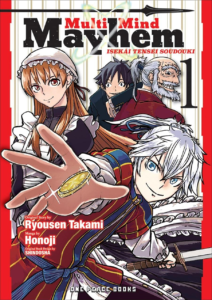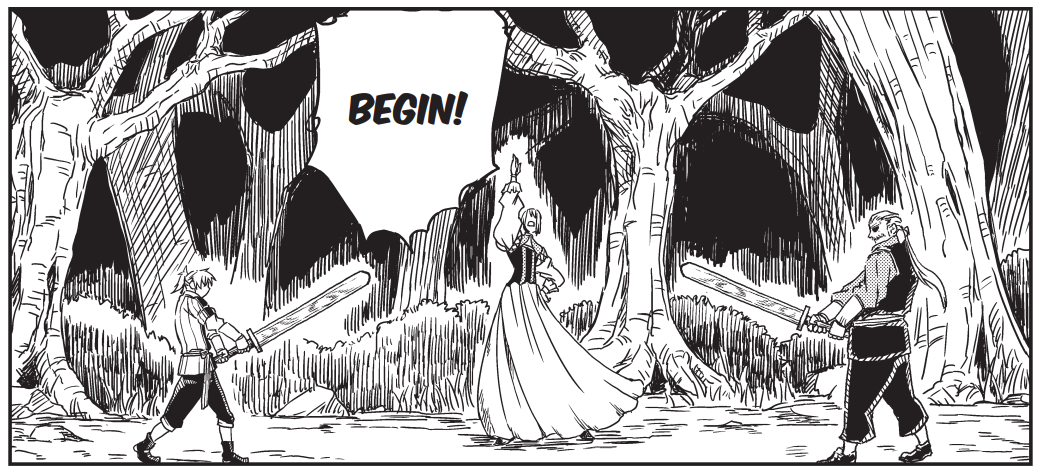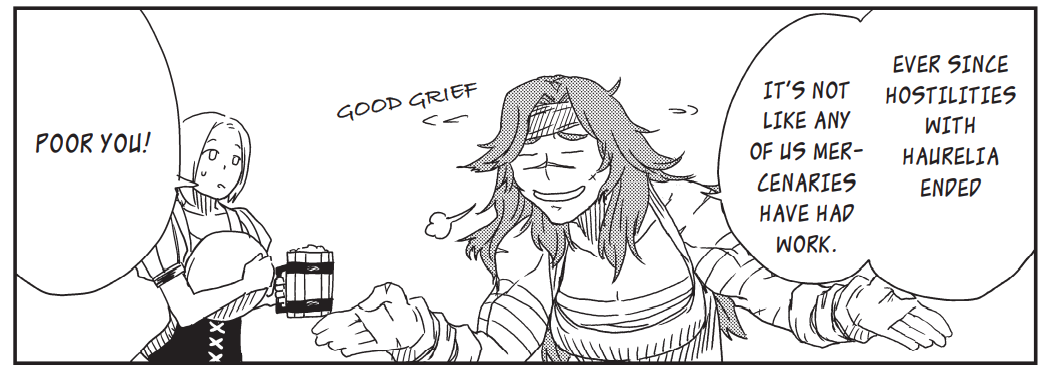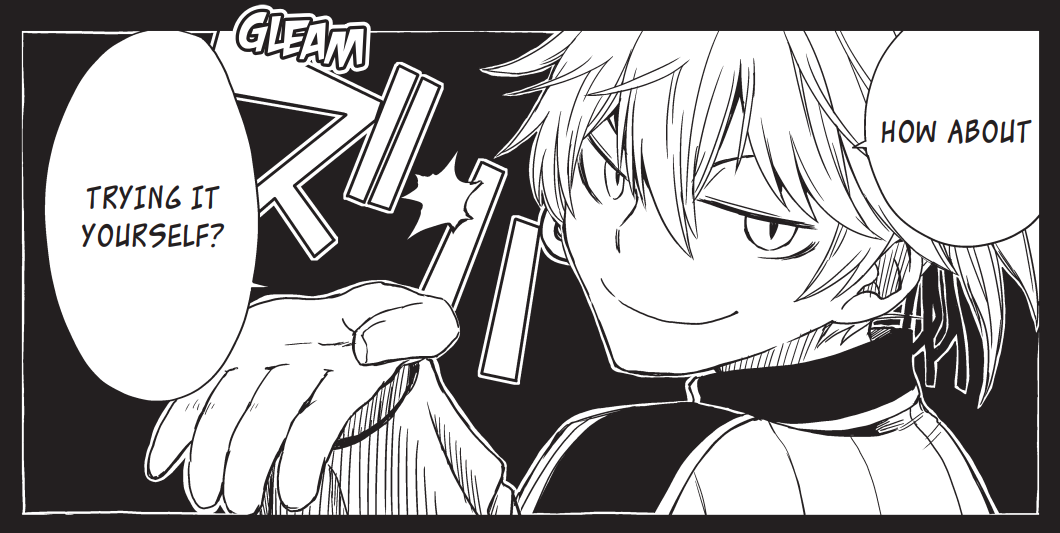Musings on Multi-Mind Mayhem
Although the modern variation of the “isekai” trope has existed within manga and anime since the early 1980s, the concept of a character swept away to a life in an alternate fantasy world has exploded in popularity and frequency during the past decade. Despite frequent parallels and similarities among isekai stories, readers still clamor for more. An example is author Ryousen Takami’s 2016 light novel series Isekai Tensei Soudouki. The novels have sold over a half-million copies and spun-off a manga adaptation by artist Honoji. One Peace Books will officially bring the Multi-Mind Mayhem: Isekai Tensei Soudouki manga series to English language readers on September 14.
As the title suggests, “Multi-Mind Mayhem” revolves around an eleven-year-old boy whose body houses not only his own spirit but also the souls of two deceased earthlings. The protagonist, Bard Cornelius is a precocious and ambitious youngster influenced by the spirits that live within him. One is a Sengoku era samurai, Oka Sanai Sadatoshi. The other is the modern era Japanese high school student Masaharu Oka. Seemingly without Bard’s awareness, the interests and knowledge of his additional psychologies influence his personality and behavior, turning him into a sort of young prodigy. The first manga volume introduces the cast, establishes Bard’s personality and potential, and concludes with the seeming first emergence of one of Bard’s secondary personalities into dominant action.
Readers with experience within the isekai genre will likely find numerous aspects of Multi-Mind Mayhem familiar. The story borrows the reborn into the child of a former mercenary concept of Rifujin na Magonote’s Mushoku Tensei (2012), the preternaturally intelligent child becoming a revolutionary merchant concept from Miya Kazuki’s Honzuki no Gekokujo (2013), the idea of a noble possessed by a reincarnated spirit taking up farming from Satoru Yamaguchi’s Otome Game no Hametsu Flag Shika Nai Akuyaku Reijou ni Tensei Shite Shimatta (2014), and the youngster developing as a talented fighter concept from Tsuyoshi Yoshioka’s Kenja no Mago (2015). Moreover, similar to author Hisago Amazake-no’s 2010 light novel series Knight’s & Magic and Yuri Kitayama’s 2014 light novel series Seirei Gensouki, the isekai aspect of the story, at least in the first volume of Multi-Mind Mayhem, isn’t especially prominent or even relevant.
The storytelling within the first volume of Multi-Mind Mayhem is serviceable, yet it feels as though it includes some odd lapses. The first chapter feels superfluous and even a bit confusing. The first chapter introduces the souls of Sadatoshi and Oka and depicts Bard’s birth. The first chapter also reveals that Bard’s father is aware that his newborn son is possessed of three distinct souls, but it’s unclear whether the father ever tells his son. The second chapter time-skips ahead eleven years, as though the first chapter was just a narrative obligation rather than a significant part of the story. Bard’s father subsequently is excluded from the ongoing story, and the story doesn’t clearly explicate whether Bard knows that his body is inhabited by two additional souls. The story continues to develop based on some tenuous plot devices. According to the setting map, the Cornelius family rules an area of land but oddly doesn’t live within that land. Moreover, the land is frequently at war with neighboring invaders that seem to have no reason for their repeated invasions. They just attack because the story needs some action. Bard refers to Gothe the local blacksmith as “famous,” but none of the other locals are aware of Gothe’s existence. The manga suggests that local merchant Selina Savaran wants to take advantage of Bard somehow, yet there’s no evidence of her having that intent. On the contrary, Bard more often seems to attempt to exploit Selina. On one occasion Bard predicts that an attack will come from the northern forest. But on the setting map there is no forest to the north, only woods to the south and east. The novel products that Bard invents and sells are described as stimulating the entire country’s economy although the products themselves seem very limited in distribution, and the story provides no evidence of them having an impact on the national economy. Magic exists in the story’s fantasy setting although magic isn’t explained at all nor does it seem to have any practical applications. Magic seems included in the story due to cliché rather than purpose. Bard is three characters in one, but in the first volume, the two secondary personalities have minimal appearances.
Similar to its writing, the manga’s illustrations are passable but rarely exceptional. Illustrator Honoji’s drafting resembles an inferior replication of Eiichiro Oda’s One Piece or Yuki Tabata’s Black Clover. The graphic art often lacks detail. Backgrounds are limited. Action scenes aren’t entirely incomprehensible as they are in some manga, but periodically individual panels are a bit difficult to decipher. During the book’s climactic action sequence, the intensity of the violence escalates somewhat, and the violence graphically increases although the bloodshed stays moderate throughout the book.
Japan Times anime expert Matt Schley provides the English translation and does a commendable job of giving characters distinct voices through accents and rhetorical styles. The book does contain some mild profanity. The story also makes some vague yet deliberate references to adult concepts, but younger readers probably won’t pay mind to these brief allusions. The first volume contains manga chapters 1-9 and four pages of supplemental 4-panel parody comic strips.
The first volume of Multi-Mind Mayhem actually contains rather little mayhem or even multiple minds. The bulk of the story is a lighthearted, humorous slice-of-life tale set in a moderately peaceful sword and sorcery world. The tale is especially familiar, but fans of the isekai genre as well as receptive readers may find that the story’s characterizations and brisk pace end up making the manga endearing despite its technical weaknesses.










